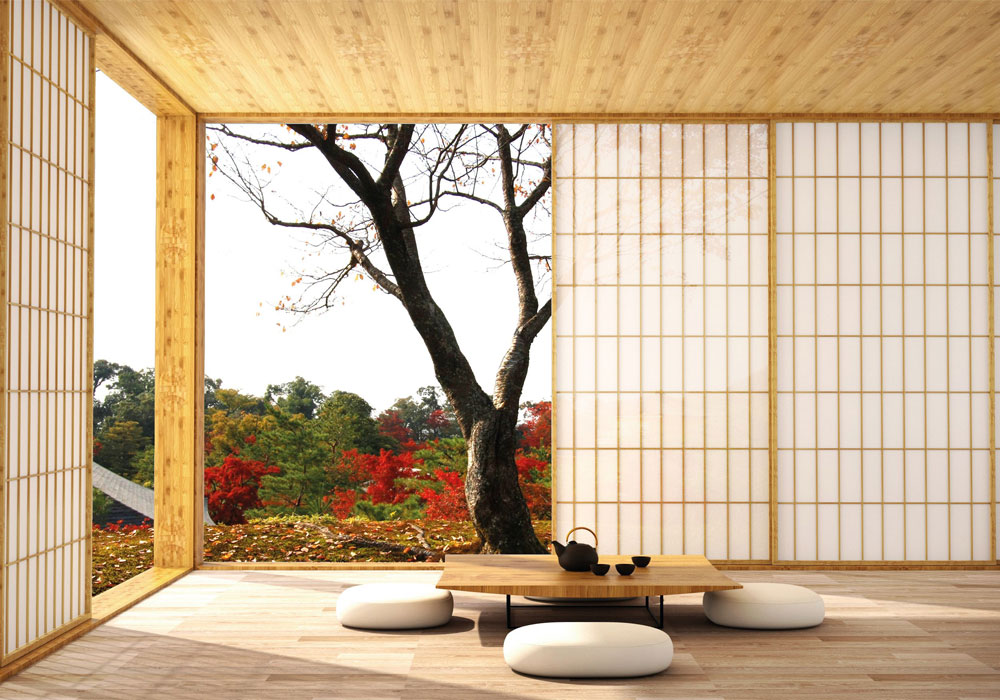
Turning Japanese
11.05.21Can you tell your Wabi-Sabi from your Hygge? Combining Japanese rustic minimalism and Scandinavian functionality can create a feeling of harmony, nature, and simplicity in your home. So why do they work so well together? Sophie Ortega investigates
They may be 8000 kilometres apart, but Japan and Scandinavia have a great deal in common – in design terms, at least. They both value simplicity and functionality, a love of natural materials, and a deep respect for craftsmanship.
In recent times, these shared attributes have produced a style known as ‘Japandi’ or ‘Japanese minimalism’ – furniture, tableware and interiors featuring clean lines, neutral tones and natural textures.
Interior design consultant Jennifer Vale defines the trend: “Aspects of the Scandi notion of ‘hygge’, (the Nordic term for the homely feeling of cosiness), and Japanese ‘wabi-sabi’, (finding beauty in imperfection), harmonise to create a stress-free atmosphere.” Japandi is a good fit with hectic modern lifestyles, because “these pieces allow people to create a clean, calm environment in which they can truly unwind.”
For many designers, it’s all about the shared aesthetics and focus on craft skills. “I really recognise that there’s this connection between the two places,” says Danish designer Nina Tolstrup. She traces it back to the 1950s and compares the classic modernist pieces from her region with pieces by Japanese designers, such as Japanese-American sculptor and designer Isamu Noguchi and Japanese industrial designer Isamu Kenmochi.
Adds Vale: “Japan still has the most amazing, best-preserved craftsmanship, and still honours traditions. They’re perfectionists in so many ways. When I bring my designs to a Japanese client, there’s the perfect match between the simple idea of form, and the execution of the craftsmanship."
So just how do you achieve a Japandi style for your rooms and your house?
Colour Curation
Perhaps for fans of fuchsia and statement neon shades, you might want to look away now. After all, Japandi colour schemes feature neutral, muted tones: think beige, taupe, oatmeal and stone. That said, it’s best to avoid anything too white or bright and nothing should jar, grate or dominate. The idea is to create a calming, harmonious atmosphere in a similar way to Biophilic design. Therefore, you can introduce warmth where needed via different materials. Coloured woods and natural fibre rugs always work well.
Japandi colour schemes however don’t have to be bland or boring. One way to avoid this, is to introduce a contrasting colour, soft Scandi shades of pale pink, blue, green or grey. Or add some richness with a darker accent colour, such as black or charcoal grey. In fact, you often see these deeper tones in Japanese interiors, and they are a clever way to add interest to minimalistic décor.
Nurture Nature
In Japan and Scandinavia, there’s an unspoken appreciation of things that are made by hand, made with care and made to last. Natural fibres and sustainable materials are therefore key elements in Japandi style. Wood is an obvious choice for furniture. Scandinavian pieces are perfect as they typically feature clean, simple lines. In Japan by contrast, stained or painted woods and curved shapes are more common, but don’t be afraid to mix and match the two styles, to increase visual interest. In addition to wood, other popular Japandi materials are bamboo, rattan and paper.
The cultivation of house plants is another key theme within Japandi design. After all, they are a simple, cost-effective way to bring nature indoors. In fact, they feel welcoming, add natural vibrancy and are useful for ‘softening’ an ultra-minimalist interior. In addition, plants can also improve air quality by reducing carbon dioxide and dust – perfect for emulating all that healthy Scandinavian air. Where space allows, mix and match potted and hanging plants. Or you could choose a Bonsai tree to emphasise your room’s Japanese feel.
Texture Treats
If you want keen to add warmth and interest to your Japandi interior, consider using different textures and fabrics. The Japanese are renowned for incorporating exquisite patterns in their décor. Cushions and curtains are an obvious place to start, but you could add throws and tableware, too. In fact, silk, velvet and cashmere are indulgent fabrics that will help to create hygge. Otherwise, you could enhance a rustic space with intricate patterns for a burst of vibrancy.
While too much decorative detail is a Japandi style no-no, well-considered statement pieces work wonderfully. The natural aspect comes forth in a wonderful mix of light and dark woods in spaces layered in tone, textures and contrasts. Match the furniture with natural and textured fabrics in simple designs or add traditional Japanese decorative elements, such as hand-painted floral wallpaper, shibori-dyed fabric, as well as dipped and handmade ceramics and textured paper lamps. You can also use shapes and textures in Japandi style with accessories. Mirrors, picture frames, table lamps, vases and even carefully curated artwork can transform the look and feel of a room.
Multi Minimalism
The minimalist Japandi vibe advocates zero clutter, which is one of the reasons why it’s so suited to small space/open plan living. However, functionality and well-being are also important. When space is at a premium, everything present needs to justify its place. If you’re not sure where to source Japandi items, NiMi Projects may be a good place to start. Established in 2018 by Japan fashion expert Nicole Bargwanna and Tokyo-based lifestyle and design editor Mio Yamada, the brand’s goal is to introduce and promote a wider appreciation of Japan’s exceptional contemporary design and artisanship in a fun and accessible way. Showcasing the work of a variety of Japanese designers and artisans, all pieces are selected for their striking aesthetics, functional innovations, and meticulous attention to detail.
Wabi-Sabi - Find the Beauty
Japandi builds on the Japanese expression wabi-sabi, a Japanese philosophy that dates back to the fifteenth century and relates to finding beauty in the incomplete and the imperfect. The trend emerged as a reaction to the dominant styles of the time, which were strongly influenced by lavishness and the use of rare materials. Want to bring out your inner wabi-sabi? Then connect yourself to the Earth and enjoy and appreciate the simple and small joys of life.
Abode Affiliates
COPYRIGHT © Abode2 2012-2025
























































































































































































































